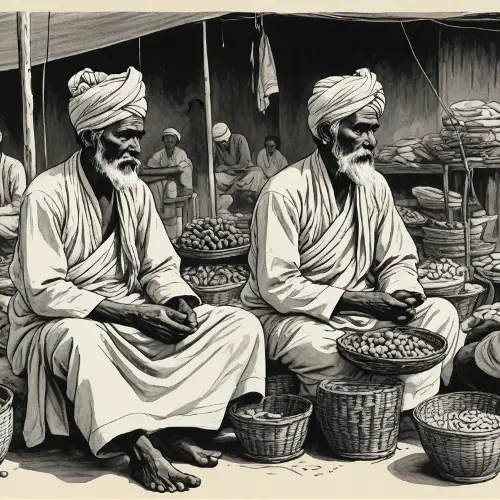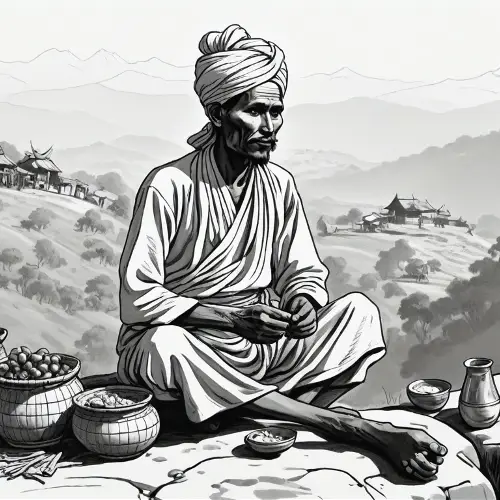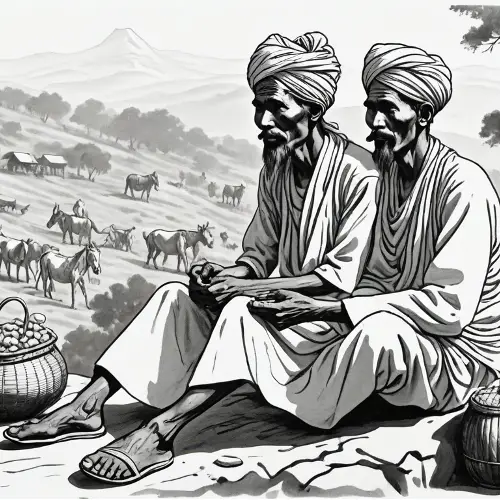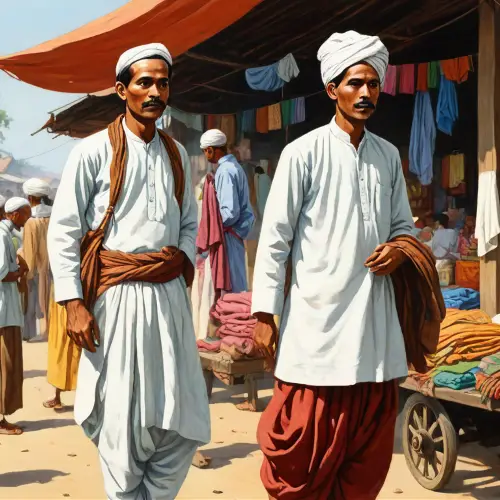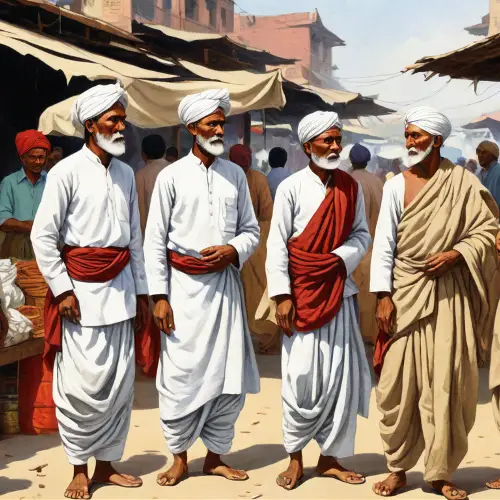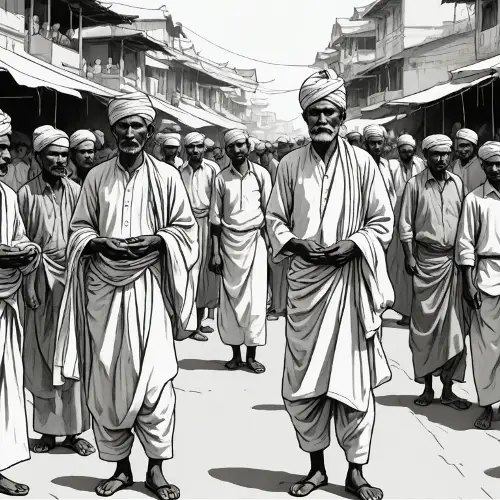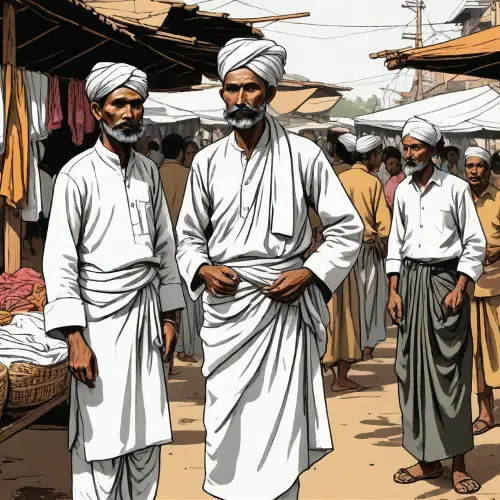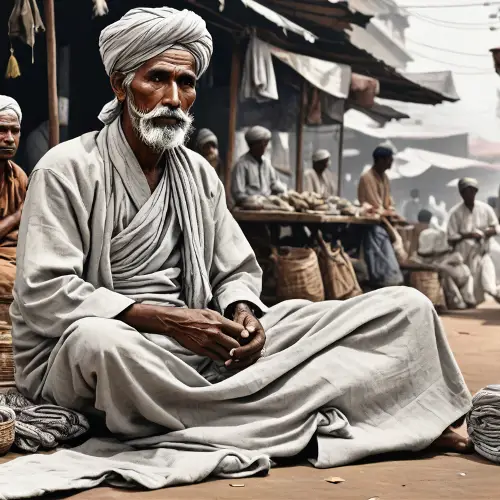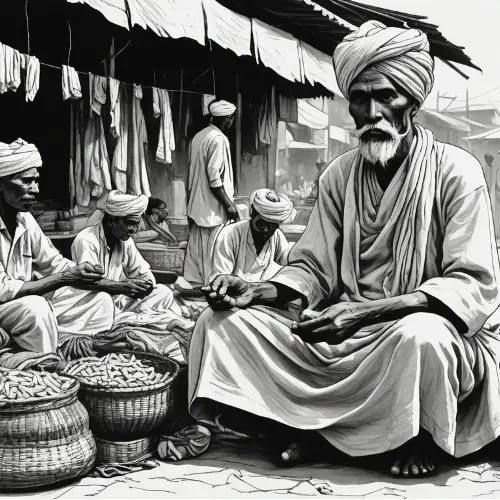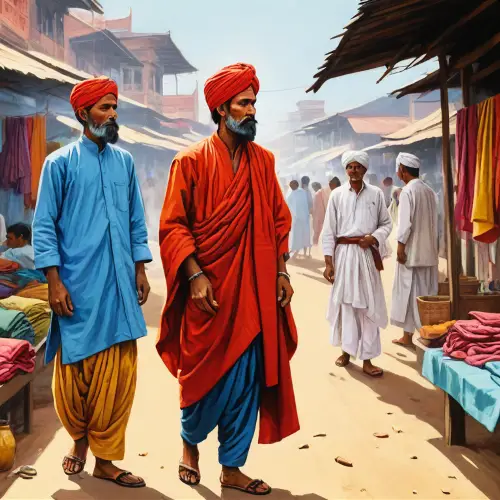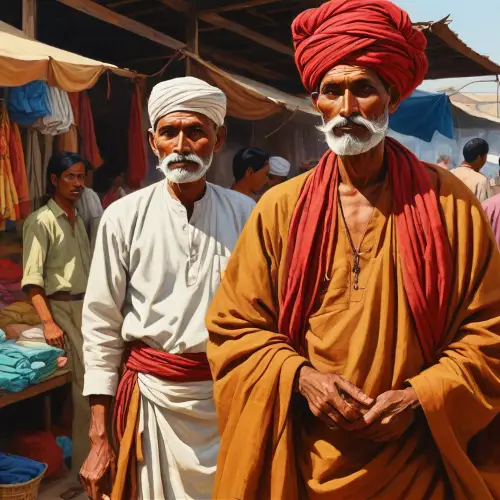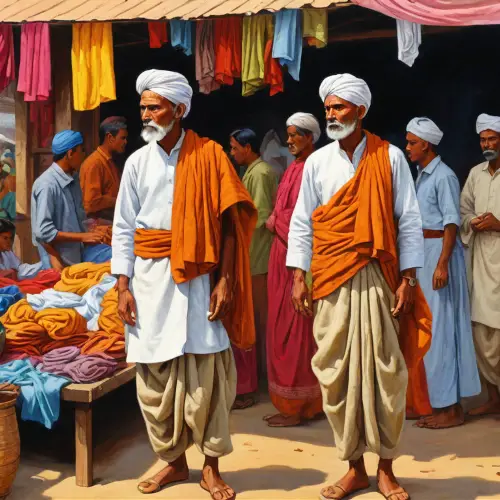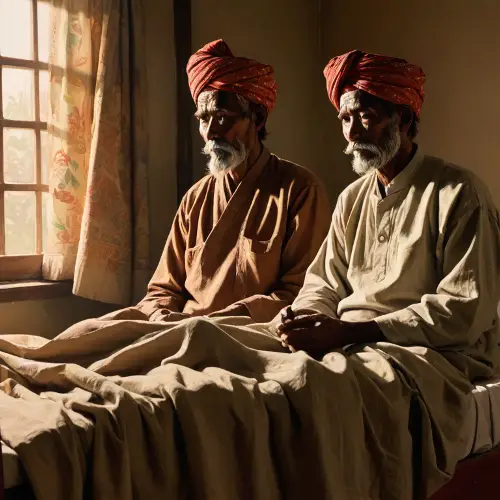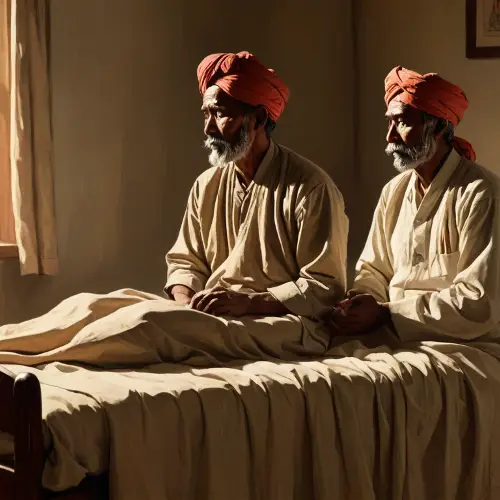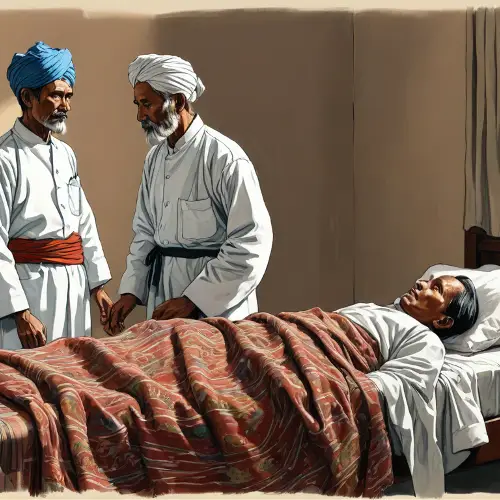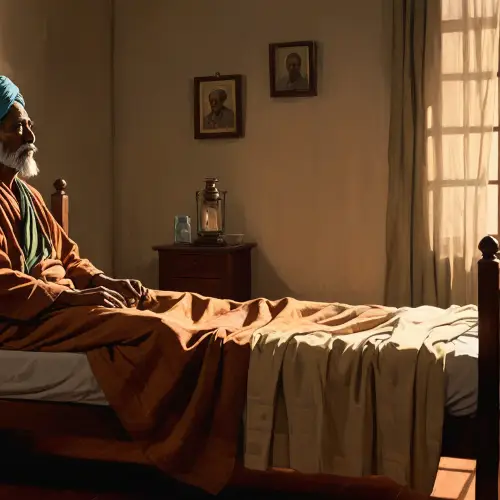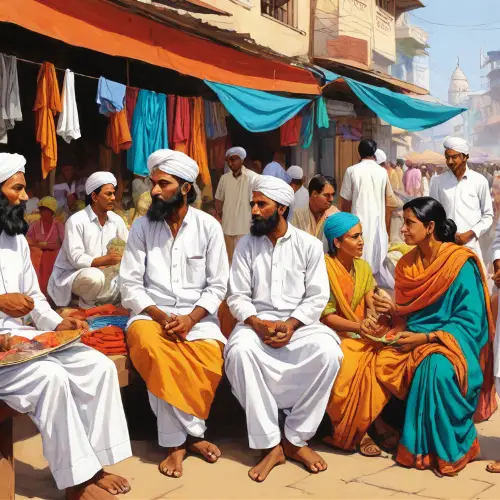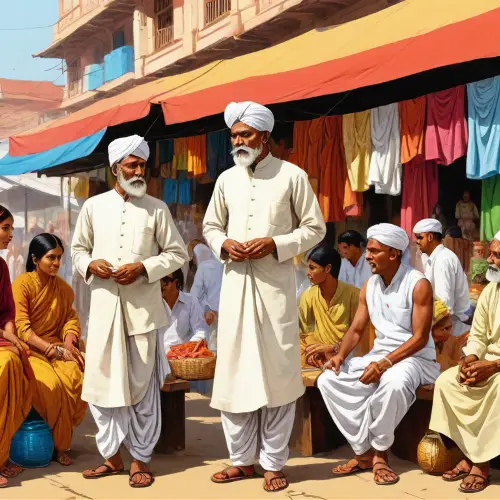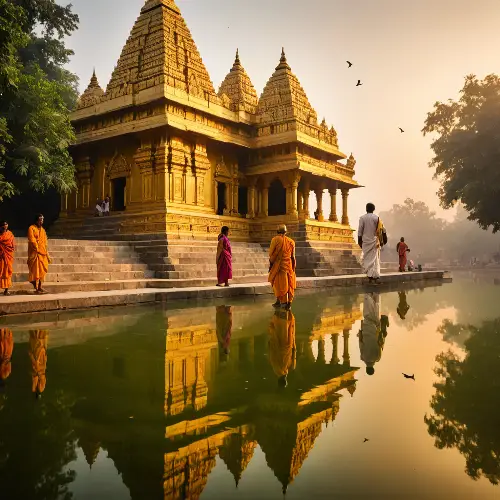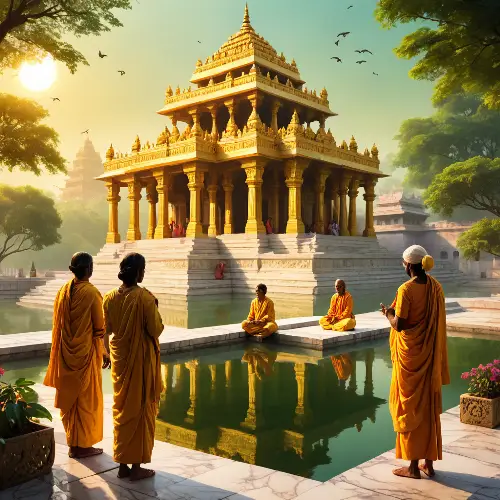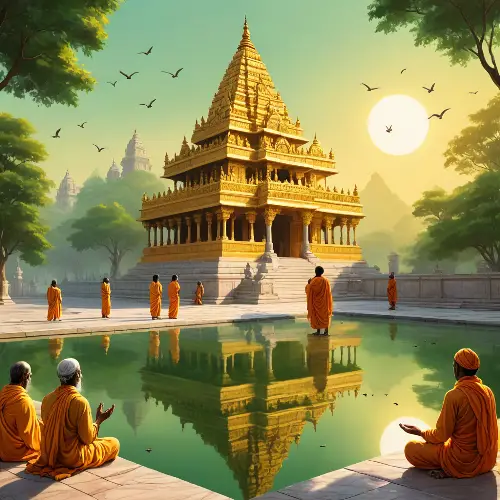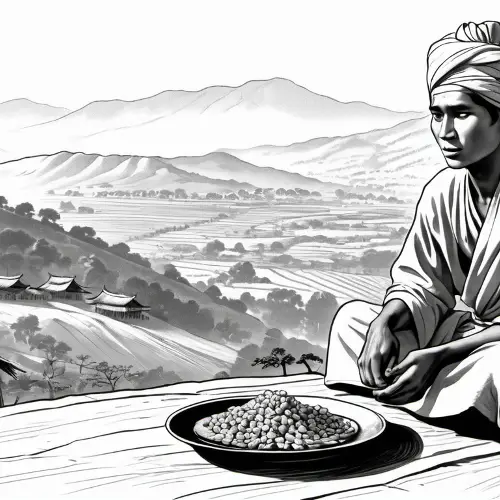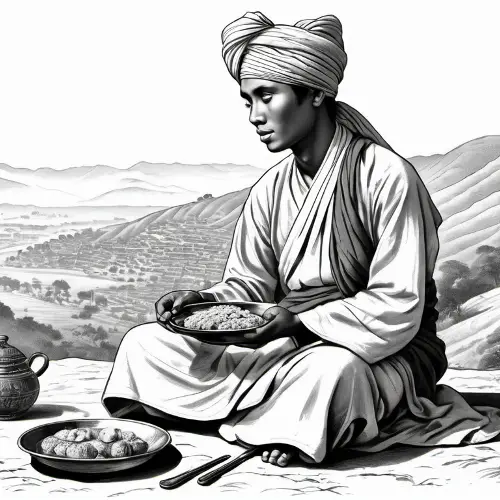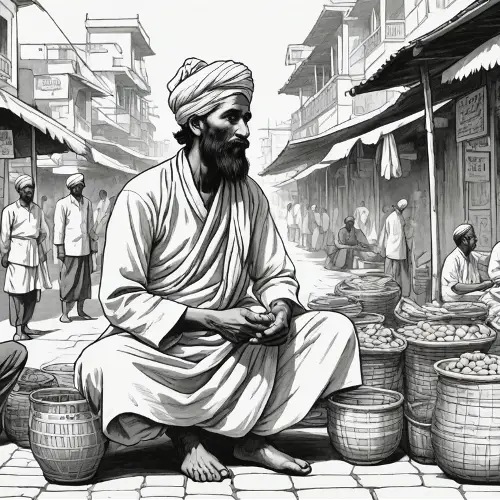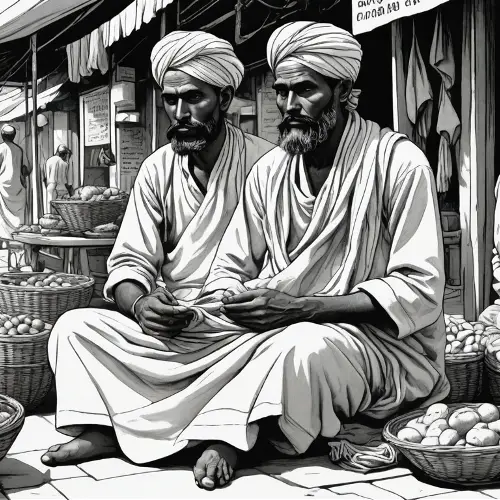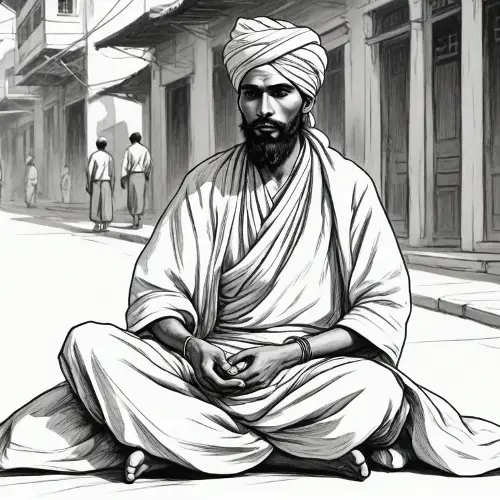The Burma House Haveli in 1890 was an architectural marvel blending Burmese and Indian styles. The exterior featured intricate carvings depicting mythical creatures and folklore scenes. The lush courtyard housed vibrant gardens, creating a serene atmosphere. Inside, teak wood furniture, tapestries, and murals adorned opulent rooms, showcasing a cosmopolitan fusion. The haveli served as a cultural hub for gatherings, fostering intellectual exchange. As the sun set, lanterns illuminated the majestic facade, reflecting the sophistication and elegance of a bygone era.
More Like This
Illustrate a serene scene within a bustling market in Burma circa 1880, featuring a charming shop with a distinctive bamboo roof. The focus should be on the architectural beauty and simplicity of the bamboo structure, which was a prevalent building material in traditional Burmese construction.
Generate a detailed line art sketch featuring a Marwadi man seated on a Burmese market street in 1887. The man is wearing a traditional turban and dhoti, facing left, and engaged in selling vibrant cloth materials. Capture the intricate details of his attire, the texture of the fabrics on display, and the historical elements of the bustling Burmese market. Illustrate the street scene with architectural nuances and the lively atmosphere of customers exploring the textile offerings. Emphasize the cultural exchange and trade dynamics in this snapshot of 1887 Burma
In a dimly lit Burmese hospital room in 1885, a Marwadi man lies on a wooden bed with closed eyes, wearing a vibrant turban and covered by an intricately patterned blanket. The atmosphere is serene, with a mix of curious onlookers, patients, and concerned family members surrounding him. A dedicated doctor, dressed in period-appropriate attire, examines a medical chart nearby. The scene captures a multicultural tapestry of Burma in the late 19th century, with soft lighting creating a poignant moment of cultural convergence and compassion.
Imagine an Indian man in the hilly region of Burma in 1880. Hes sitting on a rock or a simple surface, wearing a turban and a traditional doti. The man is depicted enjoying a meal in a serene setting. Beside him, a mule is securely tied, and luggage is neatly arranged, indicating a moment of rest during a journey. The hilly landscape features rugged terrains with greenery and perhaps a glimpse of a winding trail or distant hills. This scene captures a peaceful moment in the daily life of an individual in the hill areas of Burma during the late 19th century.
The Marwadi School Stage in Burma in 1935 serves as the backdrop for a nostalgic sketch. Picture a modest stage within the school, embodying the architectural and cultural elements of the Marwadi community. Capture the simplicity of the setting with wooden structures and basic decor. On the stage, imagine students dressed in traditional Marwadi attire, engaged in a cultural or educational event. Symbolic elements, such as books, chalkboards, and cultural artifacts, can be incorporated. The sketch should evoke the essence of education, community, and cultural exchange within the Marwadi school in Burma during the mid-20th century.
Imagine an Indian man in the hilly region of Burma in 1880. Hes sitting on a rock or a simple surface, wearing a MARWADI THIN turban and a traditional doti. The man is depicted enjoying a meal in a serene setting. Beside him, a mule is securely tied, and luggage is neatly arranged, indicating a moment of rest during a journey. The hilly landscape features rugged terrains with greenery and perhaps a glimpse of a winding trail or distant hills. This scene captures a peaceful moment in the daily life of an individual in the hill areas of Burma during the late 19th century.
Imagine a scene in the hill area of Burma in the year 1880. A distinguished man is depicted, wearing a traditional turban, kurta, and dhoti, standing with a sense of grace. His attire is detailed, reflecting the cultural nuances of the region during that period. Beside him, a mule is tethered, carrying goods or belongings, adding an element of daily life in the hills. The landscape around is hilly, with lush vegetation and perhaps a glimpse of distant mountains. The man may be holding a piece of luggage or engaged in an activity, further emphasizing the context of life in Burma during the late 19th century.
Imagine a scene in the hill area of Burma in the year 1880. A distinguished man is depicted, wearing a traditional turban, kurta, and dhoti, standing with a sense of grace. His attire is detailed, reflecting the cultural nuances of the region during that period. Beside him, a mule is tethered, carrying goods or belongings, adding an element of daily life in the hills. The landscape around is hilly, with lush vegetation and perhaps a glimpse of distant mountains. The man may be holding a piece of luggage or engaged in an activity, further emphasizing the context of life in Burma during the late 19th century.
Imagine a scene in the hill area of Burma in the year 1880. A distinguished man is depicted, wearing a traditional turban, kurta, and dhoti, standing with a sense of grace. His attire is detailed, reflecting the cultural nuances of the region during that period. Beside him, a mule is tethered, carrying goods or belongings, adding an element of daily life in the hills. The landscape around is hilly, with lush vegetation and perhaps a glimpse of distant mountains. The man may be holding a piece of luggage or engaged in an activity, further emphasizing the context of life in Burma during the late 19th century.
Imagine a scene in the hill area of Burma in the year 1880. A distinguished man is depicted, wearing a traditional turban, kurta, and dhoti, standing with a sense of grace. His attire is detailed, reflecting the cultural nuances of the region during that period. Beside him, a mule is tethered. The landscape around is hilly, with lush vegetation and perhaps a glimpse of distant mountains. The man may be holding a piece of luggage or engaged in an activity, further emphasizing the context of life in Burma during the late 19th century.
bamboo shop roof Sketch a vibrant scene capturing the cultural dynamism of a Burmese market in 1880, with a focus on a Marwadi man wearing a traditional dhoti and kurta, actively engaged in selling cloth materials while seated. Surround the merchant with the lively atmosphere of the market, including other shops and people engaging in transactions. Detail the Marwadi mans attire with precision, showcasing the intricacies of the dhoti and kurta, and emphasize the array of cloth materials on display. Illustrate the surrounding market scene with architectural elements, such as nearby shops or stalls, and include a diverse group of people, some browsing and others engaged in purchasing textiles.
Create a sketch capturing the cultural fusion in a bustling market scene in Burma circa 1880. Focus on a Marwadi man, dressed in a traditional dhoti and kurta, actively engaged in selling cloth materials. The man could be showcasing vibrant textiles characteristic of Marwadi culture. Detail the merchants attire, paying attention to the intricacies of the dhoti and kurta, as well as any accessories that might signify his cultural background. Emphasize the array of fabrics and textiles displayed in his stall of the cloth trade during that era. Surround the Marwadi cloth merchant with the diverse sights of the market – other stalls, customers exploring, and perhaps fellow merchants. Incorporate architectural elements of the market, suggesting the traditional structures and ambiance of a Burmese market in the late 19th century
Envision a scene in the hilly terrain of Burma in the year 1880. A man, adorned in a turban and traditional doti, is seated on a rock or a makeshift surface, savoring a meal. His attire is intricately detailed, reflecting the cultural identity of the region during that period. Beside him, a mule is securely tied, and luggage is neatly arranged nearby, suggesting a pause in a journey or a moment of rest during travel. The hilly backdrop features rugged landscapes, with vegetation and perhaps a glimpse of a winding trail or distant hills. The scene captures a serene moment in the daily life of Burmas hill areas in the late 19th century
Create a sketch capturing the cultural fusion in a bustling market scene in Burma circa 1880. Focus on a Marwadi man, dressed in a traditional dhoti and kurta, actively engaged in selling cloth materials. The man could be showcasing vibrant textiles characteristic of Marwadi culture.
Generate a detailed line art sketch featuring a Marwadi man seated on a Burmese market street in 1887. The man is wearing a traditional turban and dhoti, facing left, and engaged in selling cloth materials on street . Capture the intricate details of his attire, the texture of the fabrics on display, and the historical elements of the bustling Burmese market. Illustrate the street scene with architectural nuances and the lively atmosphere of customers exploring the textile offerings. Emphasize the cultural exchange and trade dynamics in this snapshot of 1887 Burma
Create a sketch capturing the cultural fusion in a bustling market scene in Burma circa 1880. Focus on a Marwadi man, dressed in a traditional dhoti and kurta, actively engaged in selling cloth materials. The man could be showcasing vibrant textiles characteristic of Marwadi culture. Detail the merchants attire, paying attention to the intricacies of the dhoti and kurta, as well as any accessories that might signify his cultural background. Emphasize the array of fabrics and textiles displayed in his stall, depicting the rich colors and textures indicative of the cloth trade during that era. Surround the Marwadi cloth merchant with the diverse sights of the market – other stalls, customers exploring, and perhaps fellow merchants. Incorporate architectural elements of the market, suggesting the traditional structures and ambiance of a Burmese market in the late 19th century. Consider the play of light and shadow on the fabrics, creating depth and visual interest in the scene. Capture the expressions on the faces of the merchant and potential customers, conveying the lively interaction in this cultural exchange. In essence, aim to portray the dynamic cultural commerce as the Marwadi man brings the vibrancy of his textiles to the bustling marketplace of 1880 Burma.
Create a sketch capturing the cultural fusion in a bustling market scene in Burma circa 1880. Focus on a Marwadi man, dressed in a traditional dhoti and kurta, actively engaged in selling cloth materials. The man could be showcasing vibrant textiles characteristic of Marwadi culture. Detail the merchants attire, paying attention to the intricacies of the dhoti and kurta, as well as any accessories that might signify his cultural background. Emphasize the array of fabrics and textiles displayed in his stall, depicting the rich colors and textures indicative of the cloth trade during that era. Surround the Marwadi cloth merchant with the diverse sights of the market – other stalls, customers exploring, and perhaps fellow merchants. Incorporate architectural elements of the market, suggesting the traditional structures and ambiance of a Burmese market in the late 19th century. Consider the play of light and shadow on the fabrics, creating depth and visual interest in the scene. Capture the expressions on the faces of the merchant and potential customers, conveying the lively interaction in this cultural exchange. In essence, aim to portray the dynamic cultural commerce as the Marwadi man brings the vibrancy of his textiles to the bustling marketplace of 1880 Burma.
In the dimly lit room of a Burmese hospital in the year 1885, a Marwadi man lies peacefully on a wooden bed, his eyes closed as if lost in the realms of slumber. The atmosphere is hushed, with only the faint sounds of distant conversations and the occasional creaking of the wooden floor. The Marwadi man is adorned in traditional attire, wearing a vibrant turban that signifies his cultural identity. The turban is neatly wrapped, its colors muted but still retaining a touch of elegance. The mans face reflects a sense of calmness, perhaps in the midst of recovery or contemplation. A thick blanket covers the Marwadi man, providing warmth in the coolness of the hospital room. The blanket is woven with intricate patterns, showcasing the craftsmanship of the region. Its edges drape gracefully over the sides of the bed. Surrounding the bed are diverse characters, each telling a story of their own. There are curious onlookers, fellow patients, and concerned family members, all with expressions that convey a mix of empathy, hope, and curiosity. The attire of the people varies, representing the multicultural tapestry of Burma in the late 19th century. A wise-looking doctor, dressed in period-appropriate medical attire, stands nearby, examining a medical chart. The doctors face reveals a mix of determination and compassion, suggesting a dedication to the well-being of the patients under their care. The lighting in the room is soft, emanating from a combination of flickering oil lamps and daylight filtering through worn curtains. Shadows dance on the walls, adding depth to the scene. This sketch captures a moment frozen in time, where cultures converge in the heart of a Burmese hospital, and the spirit of compassion transcends the boundaries of time and place.
In the dimly lit room of a Burmese hospital in the year 1885, a Marwadi man lies peacefully on a wooden bed, his eyes closed as if lost in the realms of slumber. The atmosphere is hushed, with only the faint sounds of distant conversations and the occasional creaking of the wooden floor. The Marwadi man is adorned in traditional attire, wearing a vibrant turban that signifies his cultural identity. The turban is neatly wrapped, its colors muted but still retaining a touch of elegance. The mans face reflects a sense of calmness, perhaps in the midst of recovery or contemplation. A thick blanket covers the Marwadi man, providing warmth in the coolness of the hospital room. The blanket is woven with intricate patterns, showcasing the craftsmanship of the region. Its edges drape gracefully over the sides of the bed. Surrounding the bed are diverse characters, each telling a story of their own. There are curious onlookers, fellow patients, and concerned family members, all with expressions that convey a mix of empathy, hope, and curiosity. The attire of the people varies, representing the multicultural tapestry of Burma in the late 19th century. A wise-looking doctor, dressed in period-appropriate medical attire, stands nearby, examining a medical chart. The doctors face reveals a mix of determination and compassion, suggesting a dedication to the well-being of the patients under their care. The lighting in the room is soft, emanating from a combination of flickering oil lamps and daylight filtering through worn curtains. Shadows dance on the walls, adding depth to the scene. This sketch captures a moment frozen in time, where cultures converge in the heart of a Burmese hospital, and the spirit of compassion transcends the boundaries of time and place.
Sketch a vibrant scene capturing the cultural dynamism of a Burmese market in 1880, with a focus on a Marwadi man wearing a traditional dhoti and kurta, actively engaged in selling cloth materials while seated. Surround the merchant with the lively atmosphere of the market, including other shops and people engaging in transactions. Detail the Marwadi mans attire with precision, showcasing the intricacies of the dhoti and kurta, and emphasize the array of cloth materials on display. Illustrate the surrounding market scene with architectural elements, such as nearby shops or stalls, and include a diverse group of people, some browsing and others engaged in purchasing textiles.
Creating a black and white line art image requires a visual artist or graphic designer, as it involves translating the described scene into a 2D representation with lines and shading. However, I can provide a simplified textual representation of the scene in a style reminiscent of a black and white line art description: Title: \Vipassana Serenity\ Description: Imagine a sweeping landscape in Myanmar, where a Vipassana meditation center stands as a beacon of tranquility. The retreat is nestled amid rolling hills and framed by the graceful curves of traditional Burmese architecture. Individual meditation rooms dot the scene, each a simple, standalone structure adorned with cultural nuances. Diverse meditators engage in profound introspection within their private sanctuaries. Through open windows and doors, glimpses reveal individuals in varied postures, symbolizing the unity in their solitary pursuit of inner peace. Natural light delicately illuminates the scene, casting shadows that dance across the meditation rooms and the surrounding landscape. Symbolic elements such as lotus flowers and prayer flags add a touch of cultural richness to the image. Harmony with nature prevails, as swaying trees and the gentle ripples of a nearby pond create a serene backdrop. The time of day, whether the soft glow of dawn, the warmth of midday sunlight, or the tranquil hues of dusk, sets the mood for this visual ode to Vipassana meditation.
Foreground: Pilgrims dressed in vibrant colors, slowly circumambulating the temple with hands folded in prayer. A few families gathered near the Saraswati kund, offering flowers and gazing at the mirrored reflection. A group of musicians playing devotional tunes on traditional instruments, filling the air with serenity. Temple Complex: Bathed in the soft golden light of dawn, the white marble shikhars rise majestically towards the sky. Intricate carvings on the walls shimmer with a warm glow, depicting scenes from the Ramayana. Golden flags fluttering in the gentle breeze, adorned with religious symbols and vibrant hues. Reflecting pools mirroring the serene beauty of the temple, adding a sense of stillness and depth. Background: The holy Sarayu River gently winding its way through the lush green plains, symbolizing life and purity. Distant hills veiled in a soft morning mist, adding an air of mystery and spirituality. A few birds soaring peacefully through the clear sky, their silhouettes painting graceful patterns against the golden light. Overall Tone: A sense of peace and tranquility prevails, despite the gentle hum of activity. The golden light evokes a sense of divine blessing and hopeful beginnings. The composition captures the grandeur and scale of the temple complex, harmoniously blending with its natural surroundings. graphic disign. add title text \" 22.1.2024\"
Foreground: Pilgrims dressed in vibrant colors, slowly circumambulating the temple with hands folded in prayer. A few families gathered near the Saraswati kund, offering flowers and gazing at the mirrored reflection. A group of musicians playing devotional tunes on traditional instruments, filling the air with serenity. Temple Complex: Bathed in the soft golden light of dawn, the white marble shikhars rise majestically towards the sky. Intricate carvings on the walls shimmer with a warm glow, depicting scenes from the Ramayana. Golden flags fluttering in the gentle breeze, adorned with religious symbols and vibrant hues. Reflecting pools mirroring the serene beauty of the temple, adding a sense of stillness and depth. Background: The holy Sarayu River gently winding its way through the lush green plains, symbolizing life and purity. Distant hills veiled in a soft morning mist, adding an air of mystery and spirituality. A few birds soaring peacefully through the clear sky, their silhouettes painting graceful patterns against the golden light. Overall Tone: A sense of peace and tranquility prevails, despite the gentle hum of activity. The golden light evokes a sense of divine blessing and hopeful beginnings. The composition captures the grandeur and scale of the temple complex, harmoniously blending with its natural surroundings. graphic disign. add title text \" 22.1.2024\"
Generate captivating and historically accurate images depicting a man with a turban immersed in the act of eating his food amidst the serene hills of Myanmar in the year 1837. Portray the cultural richness by highlighting the traditional Indian turban and attire against the backdrop of the Myanmar landscape. Pay meticulous attention to historical details, including the mans clothing style, the picturesque hills, and the tied horse nearby. Convey the tranquil and cross-cultural ambiance of the moment, providing a visual narrative of daily life in the Myanmar hills during the 19th century.
Title: \Serene Solitude: Vipassana Meditation Haven in Myanmar\ Description: Capture the tranquil essence of a Vipassana meditation center nestled in the heart of Myanmar. Imagine a sprawling landscape adorned with lush greenery and traditional Burmese architecture. Your image should focus on the individuality of the meditation experience within this serene retreat. Visual Elements: Exterior Overview: Begin with an expansive view of the meditation center, showcasing the harmonious blend of nature and architecture. The main meditation hall should exude a sense of peacefulness, surrounded by well-manicured gardens and shaded walkways. Individual Meditation Rooms: Zoom in to highlight the small, standalone meditation rooms scattered throughout the grounds. Each room should reflect simplicity and tranquility, adorned with minimalistic decor. Capture the unique design of each space, perhaps featuring traditional Burmese elements. Diverse Meditators: Populate the scene with individuals engaged in Vipassana meditation. Show people of different ages, backgrounds, and walks of life, all deep in contemplation within their individual meditation rooms. Emphasize the diversity of experiences while maintaining a sense of unity in the pursuit of inner peace. Meditation Postures: Illustrate various meditation postures within the rooms, showcasing the depth of the practice. Some may be seated on cushions with crossed legs, while others may prefer kneeling or sitting on meditation benches. Highlight the serenity on their faces as they delve into their introspective journey. Natural Light and Tranquil Atmosphere: Emphasize the interplay of natural light filtering into the rooms, creating a warm and peaceful ambiance. Consider incorporating subtle details like incense, gentle breezes, or soft sounds of nature to enhance the overall atmosphere. Surrounding Landscape: Show glimpses of the lush surroundings through the windows of the meditation rooms. This should evoke a sense of being in harmony with nature, reinforcing the idea that the center provides a peaceful escape from the outside world. Ensure that the image encapsulates the essence of Vipassana meditation, emphasizing the importance of solitude and introspection within the individual meditation rooms while maintaining a harmonious connection with the broader environment. black and wite sketch
Title: \Serene Solitude: Vipassana Meditation Haven in Myanmar\ Description: Capture the tranquil essence of a Vipassana meditation center nestled in the heart of Myanmar. Imagine a sprawling landscape adorned with lush greenery and traditional Burmese architecture. Your image should focus on the individuality of the meditation experience within this serene retreat. Visual Elements: Exterior Overview: Begin with an expansive view of the meditation center, showcasing the harmonious blend of nature and architecture. The main meditation hall should exude a sense of peacefulness, surrounded by well-manicured gardens and shaded walkways. Individual Meditation Rooms: Zoom in to highlight the small, standalone meditation rooms scattered throughout the grounds. Each room should reflect simplicity and tranquility, adorned with minimalistic decor. Capture the unique design of each space, perhaps featuring traditional Burmese elements. Diverse Meditators: Populate the scene with individuals engaged in Vipassana meditation. Show people of different ages, backgrounds, and walks of life, all deep in contemplation within their individual meditation rooms. Emphasize the diversity of experiences while maintaining a sense of unity in the pursuit of inner peace. Meditation Postures: Illustrate various meditation postures within the rooms, showcasing the depth of the practice. Some may be seated on cushions with crossed legs, while others may prefer kneeling or sitting on meditation benches. Highlight the serenity on their faces as they delve into their introspective journey. Natural Light and Tranquil Atmosphere: Emphasize the interplay of natural light filtering into the rooms, creating a warm and peaceful ambiance. Consider incorporating subtle details like incense, gentle breezes, or soft sounds of nature to enhance the overall atmosphere. Surrounding Landscape: Show glimpses of the lush surroundings through the windows of the meditation rooms. This should evoke a sense of being in harmony with nature, reinforcing the idea that the center provides a peaceful escape from the outside world. Ensure that the image encapsulates the essence of Vipassana meditation, emphasizing the importance of solitude and introspection within the individual meditation rooms while maintaining a harmonious connection with the broader environment. black and wite sketch
Generate a detailed line art sketch featuring a Marwadi man half seated position on a Burmese market street in 1887. The man is wearing a traditional turban and dhoti, facing left, and engaged in selling cloth materials on street . C historical elements of the bustling Burmese market. Illustrate the street scene with architectural nuances and the lively atmosphere of customers exploring the textile offerings.
burmese people meditating inside a small individual rooms arranged in a row. black and white charcoal drawing
burmese people meditating inside a small individual rooms arranged in a row. black and white charcoal drawing
LINE ART SKETCH OF MAN WEARING TURBAN DHOTI KURTA SEATING ON HALF SEATED POSITION ON STREET OF BURMA IN 1880
Generate an image of a bustling 1940s theater scene in Burma, where the President of Burma stands among a diverse crowd, eagerly watching a captivating performance. The spotlight is on a 13-year-old boy dressed as King Ashoka, delivering a spellbinding theatrical performance, surrounded by intricate props and set pieces that transport the audience to ancient times. Capture the atmosphere of anticipation, cultural richness, and historical resonance in this visually compelling moment. greyscale.
Illustrate a scene featuring a wealthy Indian family from the 1920s, now residing in Myanmar. The composition should showcase three men, three women, and three little boys within the family. Emphasize the opulence and fashion of the 1920s era, incorporating elements of traditional Indian attire. The desired artistic style is line art with a charcoal finish to evoke a vintage and timeless feel. Highlight the cultural fusion of the familys Indian roots and their contemporary lifestyle in Myanmar during the 1920s.
house luxury with a little same art of balcomb greene, arts and crafts movement, made of glass, made of wrought iron, interior with a library and flowers





